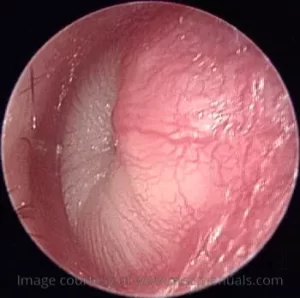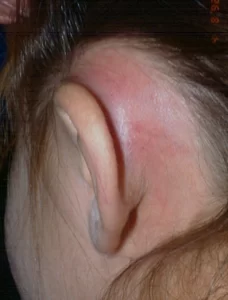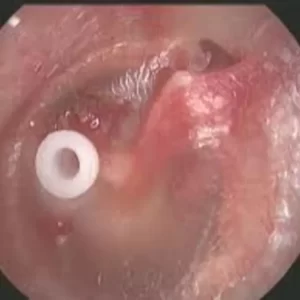Otitis Media
(Middle Ear Infection / Glue Ear)
Home | Treatments | Ear, Hearing Loss & Audiology | Otitis Media Glue Ear Middle Ear Infection
What Is Otitis Media?
 Otitis media is also known as a middle ear infection or glue ear. Otitis media is one of the most common infections in children, and is much rarer in adults. More than 90% of all children will have at least one infection by two years of age. There are two common forms:
Otitis media is also known as a middle ear infection or glue ear. Otitis media is one of the most common infections in children, and is much rarer in adults. More than 90% of all children will have at least one infection by two years of age. There are two common forms:
- Recurrent “acute” infections, or
- Long lasting “chronic” infections.
What Causes Otitis Media?
Ear infections can be caused by bacteria or viruses. Risk factors include day care day care, smoking in the home and bottle feeding. Allergies may also contribute to ear disease but are not usually the direct cause of infections. Patients with congenital syndromes such as Down syndrome, Treacher-Collins, Pierre-Robin and patients with cleft palate also have more infections due to difficulty in equalizing the pressure behind the ear drum.How Common Is Otitis Media?
Middle ear infections are the most common reasons children present to the doctor’s office. By three years of age, most children have had at least one ear infection, and 30% of children have had three or more episodes. If ear infections start before 6 months of age, your child may be more prone to otitis media and will suffer more than the usual number of infections in the first three years of life. Also, infections in newborn infants can lead to more severe complications of otitis media when compared to older children.What Are Some Symptoms Of Otitis Media?
Ear infections, for some children, are very painful. Commonly associated symptoms include:- Ear tugging
- Increased irritability or behavioral changes
- Frequent awakening at night
- Fever
- Decreased appetite
- Not wanting to lie flat
- Loss of balance
What Are Some Complications Of Otitis Media?
Otitis media will often resolve without any treatment. However, possible complications of untreated otitis media include:- A hole (perforation) of the eardrum
- hearing loss
- mastoiditis (see section below)
- meningitis (infection in the fluid surrounding the brain)
- brain abscess (pocket of pus in the brain), and/or
- blood clots in the veins of the brain
What Is Mastoiditis?
 Mastoiditis is infection or inflammation of the mastoid bone (the bone immediately behind the ear). Inside the mastoid bone there is a honeycomb-like area filled with air.
Mastoiditis occurs when otitis media spreads to this air filled area inside the mastoid bone. This complication of otitis media is uncommon today; because of the success antibiotics have in clearing up ear infections.
Suspicion of mastoiditis occurs when the patient develops redness, tenderness, and swelling behind the ear. Antibiotics are used to treat this infection. If antibiotics are not effective, surgery may be considered to clear the infection.
Mastoiditis is infection or inflammation of the mastoid bone (the bone immediately behind the ear). Inside the mastoid bone there is a honeycomb-like area filled with air.
Mastoiditis occurs when otitis media spreads to this air filled area inside the mastoid bone. This complication of otitis media is uncommon today; because of the success antibiotics have in clearing up ear infections.
Suspicion of mastoiditis occurs when the patient develops redness, tenderness, and swelling behind the ear. Antibiotics are used to treat this infection. If antibiotics are not effective, surgery may be considered to clear the infection.
When Should I See An ENT Specialist For Otitis Media?
These are guidelines which have been jointly adopted by the American Academy of Pediatrics and the American Academy of Otolaryngology (ENT physicians) with regards to otitis media and ENT specialist consultations:- If the child has three or more infections prior to six months of age
- If the child has four infections in six months OR if your child has six or more infections in a year
- If the child has fluid that lasts more than three months with associated hearing loss.
- If the child has signs of significant hearing loss.
When Are Tubes A Consideration?
Tympanostomy tubes (tubes) may be suggested when the child has failed to improve with antibiotics or has fluid which will not clear after an appropriate length of time. Tubes are especially helpful in reversing the hearing loss due to fluid trapped behind the ear drum. Tympanostomy tubes are small plastic or silicone tubes that allow more normal movement of air behind the ear drum. Tubes usually fall out of the ear (as the ear drum grows) within 6-12 months. Placement of tubes occurs through the ear canal under a brief (five to ten minutes) general anesthetic, and rarely requires a blood test or IV. The procedure is painless and allows your child to resume normal activity upon leaving the hospital. On occasion, your doctor may discuss a concurrent adenoidectomy in addition to inserting tubes, to increase the success rate of the procedure.Silicone grommet tube

Grommet tube in situ draining the ear
Ear Conditions
- Otitis Externa (External Ear Infection)
- Otitis Media (Middle Ear Infection / Glue Ear)
- Eustachian tube dysfunction
- Perforated eardrum (hole in eardrum)
- Ear Wax
- Ear Trauma
- Tinnitus

